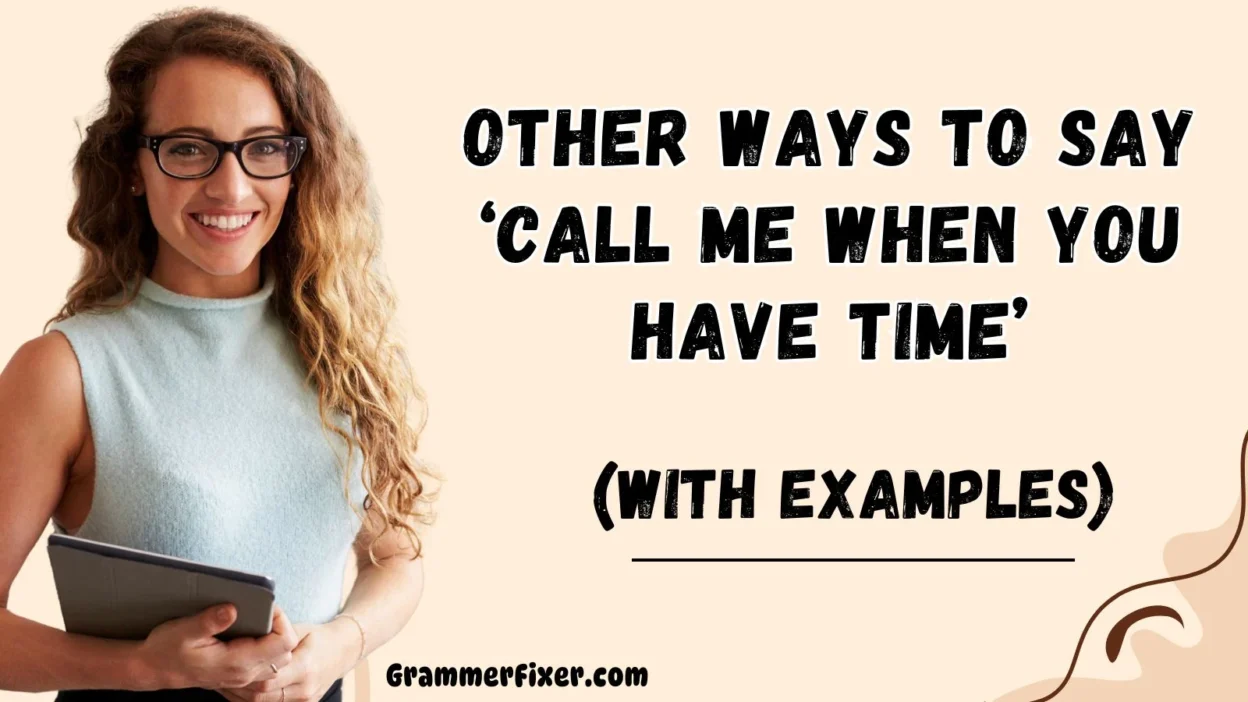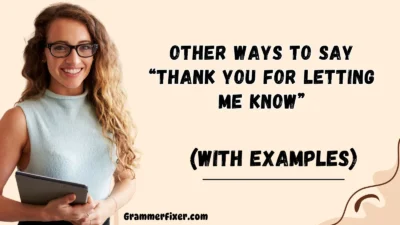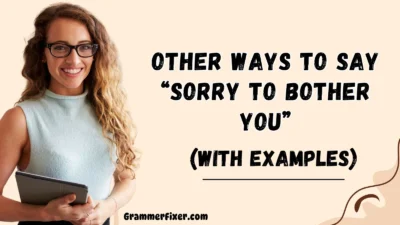Finding the right words to connect with someone—especially when you’re asking for their time—can make all the difference. Whether you’re reaching out to a colleague, client, or friend, choosing a thoughtful and respectful phrase helps you communicate with care, professionalism, and consideration.
In this article, you’ll find refined, non-demanding, and empathetic alternatives to saying “Call Me When You Have Time”—each explained with context, tone, and ideal usage so your message feels both meaningful and appropriate.
What Does “Call Me When You Have Time” Mean?
Meaning: This phrase is a polite and gentle way of asking someone to contact you when it’s convenient for them. It’s typically used to respect their schedule and to avoid sounding demanding.
Explanation: It signals that the call is important, but not urgent, and that the person can choose a suitable time to respond.
Scenario Example: “Hey! Just wanted to catch up. Call me when you have time.”
Best Use: Friendly, informal conversations or polite professional requests.
Tone: Casual, respectful, considerate.
Is It Professional/Polite to Say “Call Me When You Have Time”?
Yes, but with caveats. While it’s generally polite and non-imposing, it may feel slightly vague in more formal or time-sensitive situations. It’s best used when the topic is non-urgent and you want to leave the door open for flexible timing.
Professional Tip: In workplace settings, using more specific or refined phrasing helps ensure clarity and respect for time—especially when deadlines or deliverables are involved.
Advantage or Disadvantage
Advantages:
- Non-demanding and friendly
- Shows consideration for the other person’s time
- Allows for flexibility and comfort in communication
Disadvantages:
- Can be seen as vague or lacking urgency
- Might delay a response if the recipient doesn’t perceive it as important
1. Let Me Know When You’re Free
Meaning: You’re asking for the other person’s availability.
Explanation: Keeps the tone open and respectful by giving the other person control over timing.
Scenario Example: “Let me know when you’re free and we can jump on a call.”
Best Use: Casual and semi-formal settings.
Tone: Friendly, flexible, accommodating.
2. Whenever You Get a Moment, Give Me a Call
Meaning: You’re suggesting they call when they’re not too busy.
Explanation: Highlights understanding of their busy schedule.
Scenario Example: “I know your week is packed—whenever you get a moment, give me a call.”
Best Use: Busy professionals or friends with tight schedules.
Tone: Considerate, patient, non-demanding.
3. I’d Appreciate a Quick Call When You’re Free
Meaning: A polite, appreciative request for a call.
Explanation: It communicates gratitude and importance without urgency.
Scenario Example: “I’d appreciate a quick call when you’re free. Just need your input on something.”
Best Use: Light professional settings.
Tone: Polite, appreciative, purposeful.
4. When You Have a Minute, Let’s Talk
Meaning: Signals that the conversation isn’t urgent.
Explanation: Implies brevity and flexibility while opening the door to dialogue.
Scenario Example: “When you have a minute, let’s talk about the update.”
Best Use: Workplace check-ins or casual syncs.
Tone: Informal yet respectful.
5. Feel Free to Call Me at Your Convenience
Meaning: Encourages a return call based on the other person’s schedule.
Explanation: Projects patience and politeness.
Scenario Example: “Feel free to call me at your convenience if anything’s unclear.”
Best Use: Client communication or customer service.
Tone: Professional, polished, courteous.
6. Reach Out When It’s a Good Time for You
Meaning: Gives the power of timing to the recipient.
Explanation: Emphasizes flexibility and non-imposition.
Scenario Example: “Reach out when it’s a good time for you—we can walk through the presentation.”
Best Use: Team discussions or collaborative tasks.
Tone: Cooperative, flexible, thoughtful.
7. Ping Me When You’re Available
Meaning: Casual prompt for contact.
Explanation: Often used in tech or startup settings.
Scenario Example: “Ping me when you’re available, and we’ll coordinate.”
Best Use: Informal teams, Slack or chat-based environments.
Tone: Casual, friendly, modern.
8. Give Me a Shout When You Can
Meaning: Informal way to say call me.
Explanation: Friendly and non-demanding phrasing.
Scenario Example: “Give me a shout when you can—want to run something by you.”
Best Use: Close colleagues or friends.
Tone: Casual, easygoing.
9. Let’s Catch Up When You’re Free
Meaning: An invitation to reconnect.
Explanation: Shows warmth and eagerness to engage.
Scenario Example: “Let’s catch up when you’re free—it’s been too long!”
Best Use: Reconnecting with colleagues, friends, or past clients.
Tone: Warm, personal, open.
10. Just Drop Me a Line When You Have a Moment
Meaning: Encourages a brief message or call.
Explanation: Suitable when you’re okay with waiting and want to keep it light.
Scenario Example: “No rush—just drop me a line when you have a moment.”
Best Use: Follow-up or check-in scenarios.
Tone: Relaxed, friendly.
11. Call Me Whenever It’s Convenient for You
Meaning: A respectful way to offer flexibility.
Explanation: Helps maintain professionalism while being mindful of the recipient’s schedule.
Scenario Example: “Call me whenever it’s convenient for you—we’ll go over the changes.”
Best Use: Client or partner communication.
Tone: Polite, flexible, respectful.
12. I’m Around—Give Me a Ring When You’re Free
Meaning: Suggests that you’re available and open for a call.
Explanation: Balances friendliness with readiness.
Scenario Example: “I’m around today—give me a ring when you’re free.”
Best Use: Colleague check-ins or casual project discussions.
Tone: Approachable, casual, informal.
13. Let’s Talk When You’re Ready
Meaning: Communicates patience and understanding.
Explanation: Offers emotional space, often helpful in sensitive or stressful situations.
Scenario Example: “Take your time—let’s talk when you’re ready.”
Best Use: Personal or emotional discussions.
Tone: Supportive, caring, thoughtful.
14. Drop Me a Call When It Suits You
Meaning: Grants full flexibility to the other person.
Explanation: A considerate expression that puts zero pressure on the recipient.
Scenario Example: “Drop me a call when it suits you—happy to help.”
Best Use: Busy professionals, clients, or informal conversations.
Tone: Relaxed, courteous, accommodating.
15. No Rush—Call Me When You Can
Meaning: Assures there’s no urgency involved.
Explanation: Removes pressure while still expressing interest.
Scenario Example: “No rush—call me when you can so we can finalize the plan.”
Best Use: Updates or follow-ups that can wait.
Tone: Calm, empathetic.
16. I’d Love to Chat—Let Me Know When You’re Free
Meaning: Expresses interest in connecting warmly.
Explanation: Combines care and curiosity.
Scenario Example: “I’d love to chat—let me know when you’re free to connect.”
Best Use: Reconnecting, casual relationships.
Tone: Friendly, warm, inviting.
17. I’m Free Whenever You Are
Meaning: Indicates your availability while respecting theirs.
Explanation: Implies openness and adaptability.
Scenario Example: “I’m free whenever you are—happy to adjust.”
Best Use: Scheduling collaborative meetings.
Tone: Flexible, neutral, considerate.
18. Ring Me When the Time Is Right for You
Meaning: A poetic and polite request.
Explanation: Useful when you want to soften the ask with grace.
Scenario Example: “Ring me when the time is right for you—we’ll explore the proposal.”
Best Use: Creative industries or soft-sell business communication.
Tone: Elegant, polite, artistic.
19. If You’re Up for It, Give Me a Quick Call
Meaning: Suggests the idea without applying pressure.
Explanation: Makes it sound like a light, optional task.
Scenario Example: “If you’re up for it, give me a quick call. It’s just a short thing.”
Best Use: Informal updates or favor requests.
Tone: Easygoing, casual, collaborative.
20. Feel Welcome to Call Me Anytime
Meaning: An invitation that implies openness and comfort.
Explanation: Encourages contact without making demands.
Scenario Example: “Feel welcome to call me anytime—really appreciate your insights.”
Best Use: Mentorship, support roles, or team leadership.
Tone: Supportive, kind, nurturing.
21. I’m Open for a Call Whenever It Works for You
Meaning: Emphasizes your availability without rushing the other person.
Explanation: Great for keeping things informal yet clear.
Scenario Example: “I’m open for a call whenever it works for you this week.”
Best Use: Friendly business exchanges.
Tone: Neutral, friendly.
22. Just Call When You’re Not Tied Up
Meaning: Suggests calling when they’re not busy.
Explanation: A casual, non-intrusive phrase that acknowledges busyness.
Scenario Example: “Just call when you’re not tied up—we’ll walk through it.”
Best Use: Casual or peer-to-peer conversation.
Tone: Relaxed, natural.
23. Let’s Schedule a Call When You’re Available
Meaning: A more structured version of the phrase.
Explanation: Balances casualness with action and clarity.
Scenario Example: “Let’s schedule a call when you’re available next week.”
Best Use: Project discussions, status updates.
Tone: Organized, respectful.
24. I’d Be Happy to Talk—Whenever You Have the Time
Meaning: Adds friendliness to a flexible message.
Explanation: Keeps the door open while making the recipient feel valued.
Scenario Example: “I’d be happy to talk—whenever you have the time to connect.”
Best Use: Light-hearted professional outreach.
Tone: Pleasant, open, affirming.
25. No Pressure—Reach Out If/When You Can
Meaning: A zero-pressure way to prompt a call.
Explanation: Communicates total patience and emotional awareness.
Scenario Example: “No pressure—reach out if/when you can.”
Best Use: Follow-ups, relationship building, stress-sensitive cases.
Tone: Kind, empathetic, patient.
26. Let Me Know a Good Time for You
Meaning: Encourages mutual scheduling.
Explanation: Keeps the decision in the recipient’s hands.
Scenario Example: “Let me know a good time for you and we’ll get on a call.”
Best Use: Meetings, check-ins, formal or informal settings.
Tone: Balanced, proactive, courteous.
27. Call Me When It Feels Right
Meaning: Allows emotional space and natural timing.
Explanation: Very useful in personal, emotionally charged, or sensitive situations.
Scenario Example: “I understand it’s a lot—call me when it feels right.”
Best Use: Grief, conflict resolution, or personal support.
Tone: Compassionate, gentle, understanding.
28. Get in Touch When You Have a Free Minute
Meaning: Suggests light urgency without pressure.
Explanation: A polite prompt that still respects their time.
Scenario Example: “Get in touch when you have a free minute to chat about the numbers.”
Best Use: Team or peer updates, light follow-up.
Tone: Polite, easygoing.
29. Hit Me Up When You’re Good
Meaning: A very casual, informal variation.
Explanation: Extremely relaxed, suitable for close peers or friends.
Scenario Example: “Hit me up when you’re good—we’ll brainstorm later.”
Best Use: Close colleagues, friends, or startup culture.
Tone: Playful, casual, youthful.
30. I’m Around—Reach Out If You Feel Like Talking
Meaning: Signals availability and emotional openness.
Explanation: Great for letting someone know you’re present without any pressure.
Scenario Example: “Just so you know, I’m around—reach out if you feel like talking.”
Best Use: Emotional support, personal communication.
Tone: Warm, open, gentle.
Conclusion
Using empathetic, thoughtful, and professional phrasing when requesting a call makes a big difference in how your message is received. Whether you’re in a professional setting or reaching out to a friend, these 30 alternatives offer varying levels of tone, formality, and intent—from casual catch-ups to deadline-sensitive follow-ups.
By choosing the right words, you not only improve your communication clarity but also strengthen mutual respect, rapport, and collaboration. Whether it’s through subtle encouragement or direct action, these alternatives ensure your tone is considerate, polished, and perfectly matched to the context.



